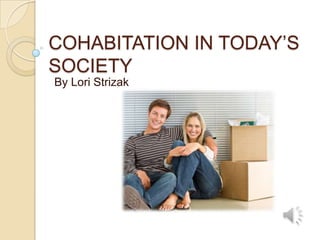
Strizak powerpointsummer2012
- 1. COHABITATION IN TODAY’S SOCIETY By Lori Strizak
- 2. Overview What is cohabitation? Current trends Types of cohabitation Who cohabits? Pros and cons to cohabiting Does it lead to better marriages? What effects does it have on children?
- 3. Cohabitation… what is it? Cohabitation occurs when two unrelated people, who are also not married, are in a sexual relationship and living together, (Benokraitis, 2011). The U.S. Census Bureau calls these individuals, POSSLQs, (person’s of the opposite sex sharing living quarters), but this can also pertain to individuals in same sex relationships who live together.
- 4. Growth and attitudes Cohabitation is continually rising. Reasons for why the numbers still might be too low: common-law marriages, couples don’t disclose the information, the U.S. Census Bureau doesn’t tabulate unmarried couples in one home, and etc. Increased acceptance among people Reasons people disapprove: religious views, morals, belief it had a negative impact on children, and etc.
- 5. Types of Cohabitation Dating cohabitation: Couple who spends a lot of time together, decides to move in together. Premarital cohabitation: Couples testing the relationship before they jump into getting married; can be engaged. Trial marriage: Less sure about relationship than a couple participating in premarital cohabitation. Substitute marriage: Two people who don’t plan to marry, but make the long term commitment to move in together.
- 6. Who cohabits? 20% are 24 years old or younger, (Benokraitis, 2011) 56% between 25-44 years old, (Benokraitis, 2011) Women are more likely to cohabit if their mothers did Also, women are less likely to cohabit if their mother’s have a college degree. Highest cohabitation rates are among American Indians/Native Alaskans and African Americans, (Benokraitis, 2011). Religion and social class also affect who cohabits.
- 7. Pros Emotional security Independence Can get out of relationship easier, without legal issues By holding off on marriage, the older in age one is, the less likely of a divorce. Age is a predictor of a stable marriage, (Benokraitis, 2011). Some children of low economic statuses benefit more Don’t deal with the stress of the other’s family (in-laws) Learn to deal with partner’s faults
- 8. Cons Feel trapped or isolated from friends Weaker commitment to the relationship Not as happy or satisfied in relationship Less likely to be faithful Show more negative and controlling behaviors after marriage No U.S. laws about the responsibilities of cohabitants
- 9. Does it lead to better marriages? Surprisingly, NO Higher divorce rates if cohabitation occurred before marriage, (Benokraitis, 2011). Three effects that could explain the reason: selection effect, cohabitation effect, and the inertia effect.
- 10. The Selection Effect People who cohabit, (usually before marriage), have different characteristics than those who don’t cohabit before marriage. Due to individual problems of the people in the relationship, people are less likely to work on the relationship, communicate efficiently, or compromise during arguments.
- 11. The Cohabitation effect Cohabitants get used to independence Not as willing to compromise, due to being used to getting there own way. Leads to instability, and the likelihood of divorce
- 12. Applying the concept In a 2009 article published in the Journal of Family Psychology, 1,050 men and women were given a random telephone survey asking about cohabitation practices and certain qualities about their marriages. Only those aged 18-34, that have been married for 10 years or less were used. All different races and ethnicities were used. “We found evidence that cohabiting before engagement, even only with one’s future spouse, is associated with lower marital quality and higher divorce potential,” (Rhoades, Stanley, & Markman, 2009).
- 13. The Inertia Effect When a couple moves in together, occasionally they make certain decisions that would make it harder to leave the relationship I.e. Getting a pet, sharing finances, having children, etc. After making these decisions, they decide that they should just go ahead and get married.
- 14. What Does This Do To Children? Children often endure the cohabitant’s breakup, or deal with the parent’s “serial cohabitation”, (living with multiple partners throughout their childhood). They are more likely to be poor, due to cohabitant’s breaking up, hence suffering from more emotional, behavioral and academies issues,
- 15. Did you know? In some states, such as North Carolina, North Dakota, West Virginia, Florida, Michigan, Mississippi, and Virginia, cohabitation is prohibited!
- 16. Summary Cohabitation is when two people, that are unrelated and not married live together, and currently are in a sexual relationship. Cohabitation is continuing to grow and is becoming a more accepted practice. There are four different types of cohabitation: dating, premarital, trial marriage and substitute marriage. Most of cohabitants are under the age of 44 Women are more likely to cohabit if their mother’s did Social class and religion also affect cohabitation rates.
- 17. Summary Cont. There are pros and cons to cohabitation Cohabitation before marriage DOES NOT mean that marriages will be better, and generally these cohabitants have higher divorce rates. Selection Effect, Cohabitation Effect, and Inertia Effect are possible theories for why it doesn’t lead to a better marriage. Sometimes, cohabitations creates an unstable environment to raise a child in, and the child is more at risk of emotional, behavioral, or academic issues if he or she witnesses serial cohabitation or the breaking up of cohabitants.
- 18. References Benokraitis, N.V. (2011). Marriages & families: Changes, choices, and constraints. (7th ed.) Boston, Massachusetts: Pearson Education, Inc. Rhoades, G. K., Stanley, S. M., & Markman, H. J. (2009). The pre- engagement cohabitation effect: A replication and extension of previous findings. Journal of Family Psychology, 23 (1), 107-11.